Current Trends and Future Directions in Knowledge Management in Construction Research Using Social Network Analysis
Abstract
1. Introduction
- What are the research approaches that could be used to explore SNA for KM?
- What are the current trends for using SNA in construction?
- What are the research gaps related to using SNA for KM in construction?
2. SNA as a Tool for Analysing Social Relationships
- Degree centrality indicates the influence or power of network members [28]. Kim et al. [7] stated that degree refers to the number of relationships maintained by each member in a network. In-degree refers to incoming connections while out-degree refers to outgoing connections. In-degree connections indicate a member’s popularity (prominence), while a person with a high out-degree is considered as an influential member in the network [29].
- Closeness centrality indicates the integration or isolation of network members [28]. According to Kim et al. [7], it is measured as the sum of distances between members. Nodes that are at a comparatively shorter distance would receive information sooner than other nodes that are away from others [30]. High closeness centrality signifies the greater autonomy of an individual member due to the ease of reaching out to other members [28]. On the other hand, low centrality denotes higher individual member dependency on other members.
- Betweenness centrality indicates the extent to which a member sits between others in the network [7]. It refers to the role played by a member as an intermediary and determines whether a member plays an important role as a broker or a gatekeeper within a network [28]. Structurally important nodes are well positioned to control information flows and create bottlenecks that slow the network down [30].
- Tie strength assists in assessing the degree of connectivity of members in a network and the likelihood that information flows between members [7]. Tie strength is measured by the number of relationships between members [28]. When the tie strength between 2 members is high, they are more motivated to provide information to the other member.
- Density presents the overall linkage between network members. Density is measured by dividing the total number of ties by the total number of possible ties [28]. According to Chinowsky et al. [31], if the density is high, it indicates that the number of relationships that exist in the network is high.
3. Research Methodology
4. Findings
4.1. Research Approaches to Explore the Use of SNA for KM
4.1.1. SNA in KM Research Designs
4.1.2. Use of SNA Measures
4.1.3. SNA Network Presentation
4.2. Discussion on Findings
4.2.1. Trends and Extensions of SNA in KM Research
4.2.2. Research Gaps and Future Research Directions
5. Conclusions
- Construction organisations could consider using SNA as a tool to identify and strengthen knowledge sharing networks
- Construction project managers could use SNA as a tool to identify, classify, and prioritise key stakeholders and enhance their knowledge sharing and communication processes
- Professional bodies and relevant organisations could consider use of SNA as a tool to create industry-wide knowledge management networks
- Government and other policy makers could encourage the industry to use SNA and knowledge management networks towards circular economy in construction
Author Contributions
Funding
Conflicts of Interest
References
- Cross, R. Managing for knowledge: Managing for growth. Knowl. Manag. 1998, 1, 9–13. [Google Scholar]
- Koskines, K.U. Knowledge Mangement to improve Project Communication and Implementation. Proj. Manag. J. 2004, 35, 13–19. [Google Scholar] [CrossRef]
- Brookes, N.J.; Morton, S.C.; Dainty, A.R.J.; Burns, N.D. Social processes, patterns and practices and project knowledge management: A theoretical framework and an empirical investigation. Int. J. Proj. Manag. 2006, 24, 474–482. [Google Scholar] [CrossRef]
- Allen, J.; James, A.D.; Gamlen, P. Formal versus informal knowledge networks in R&D: A case study using social network analysis. R D Manag. 2007, 37, 179–196. [Google Scholar]
- Barão, A.; de Vasconcelos, J.B.; Rocha, Á.; Pereira, R. A knowledge management approach to capture organizational learning networks. Int. J. Inf. Manag. 2017, 37, 735–740. [Google Scholar] [CrossRef]
- Alavi, M.; Leidner, D.E. Review: Knowledge Management and Knowledge Management Systems: Conceptual Foundations and Research Issues. MIS Q. 2001, 25, 107–136. [Google Scholar] [CrossRef]
- Kim, S.; Suh, E.; Jun, Y. Building a Knowledge Brokering System using social network analysis: A case study of the Korean financial industry. Expert Syst. Appl. 2011, 38, 14633–14649. [Google Scholar] [CrossRef]
- Pathirage, C.P.; Amaratunga, D.G.; Haigh, R.P. The role of tacit knowledge in the construction industry: Towards a definition. In Proceedings of the CIB W89 International Conference on Building Education and Research (BEAR), Heritance Kandalama, Sri Lanka, 11–15 February 2008. [Google Scholar]
- Egbu, C.O.; Robinson, H.S. Construction as a Knowledge-Based Industry. In Knowledge Management in Construction; Anumba, C.J., Egbu, C.O., Carrillo, P.M., Eds.; Wiley-Blackwell Publishing Ltd.: Oxford, UK, 2005; pp. 31–48. [Google Scholar]
- Senaratne, S.; Ruwanpura, M. Communication in construction: A management perspective through case studies in Sri Lanka. Archit. Eng. Des. Manag. 2015, 12, 3–18. [Google Scholar] [CrossRef]
- Senaratne, S.; Sexton, M. Managing construction project change: A knowledge management perspective. Constr. Manag. Econ. 2008, 26, 1303–1311. [Google Scholar] [CrossRef]
- Pathirage, C.P.; Amaratunga, D.G.; Haigh, R.P. Tacit knowledge and organisational performance: Construction industry perspective. J. Knowl. Manag. 2007, 11, 115–126. [Google Scholar] [CrossRef]
- Robinson, H.S.; Carrillo, P.M.; Anumba, C.J.; Al-Ghassani, A.M. Knowledge management practices in large construction organisations. Eng. Constr. Archit. Manag. 2005, 12, 431–445. [Google Scholar] [CrossRef]
- Shi, Q.; Wang, Q.; Guo, Z. Knowledge sharing in the construction supply chain: Collaborative innovation activities and BIM application on innovation performance. Eng. Constr. Archit. Manag. 2021. [Google Scholar] [CrossRef]
- Argote, L.; Ingram, P. Knowledge Transfer: A Basis for Competitive Advantage in Firms. Organ. Behav. Hum. Decis. Process. 2000, 82, 150–169. [Google Scholar] [CrossRef]
- Senaratne, S.; Jin, X.-H.; Balasuriya, K. Exploring the role of networks in disseminating construction project knowledge through case studies. Eng. Constr. Archit. Manag. 2017, 24, 1281–1293. [Google Scholar] [CrossRef]
- Welege, N.M.H.; Pan, W.; Kumaraswamy, M. Social network analysis applications in sustainable construction and built environment management: A review. Built Environ. Proj. Asset Manag. 2021, 11, 511–528. [Google Scholar] [CrossRef]
- Wasserman, S.; Faust, K. Social Networks Analysis: Methods and Applications; Cambridge University Press: Cambridge/London, UK, 1994. [Google Scholar]
- Prell, C. Social Network Analysis–History, Theory & Methodology, 1st ed; SAGE Publications Ltd.: London, UK, 2012. [Google Scholar]
- Senaratne, S.; Sexton, M.G. Role of knowledge in managing construction project change. Eng. Constr. Archit. Manag. 2009, 16, 186–200. [Google Scholar] [CrossRef]
- Herrera, R.F.; Mourgues, C.; Alarcón, L.F.; Pellicer, E. Comparing Team Interactions in Traditional and BIM-Lean Design Management. Buildings 2021, 11, 447. [Google Scholar] [CrossRef]
- Müller-Prothmann, T. Leveraging Knowledge Communication for Innovation: Framework, Methods, and Applications of Social Network Analysis in Research and Development, 1st ed; Peter Lang Publishing: New York, NY, USA, 2007. [Google Scholar]
- Serrat, O. Social Network Analysis. In Knowledge Solutions; Springer: Singapore, 2017; pp. 39–43. [Google Scholar]
- Jamali, M.; Abolhassani, H. Different Aspects of Social Network Analysis. In Proceedings of the 2006 IEEE/WIC/ACM International Conference on Web Intelligence (WI 2006 Main Conference Proceedings) (WI’06), Hong Kong, China, 18–22 December 2006. [Google Scholar]
- Hanneman, R.A.; Riddle, M. Introduction to Social Network Methods; University of California: Riverside, CA, USA, 2005. [Google Scholar]
- Camarasa, C.; Heiberger, R.; Hennes, L.; Jakob, M.; Ostermeyer, Y.; Rosado, L. Key Decision-Makers and Persuaders in the Selection of Energy-Efficient Technologies in EU Residential Buildings. Buildings 2020, 10, 70. [Google Scholar] [CrossRef]
- Maskil-Leitan, R.; Gurevich, U.; Reychav, I. BIM Management Measure for an Effective Green Building Project. Buildings 2020, 10, 147. [Google Scholar] [CrossRef]
- Müller-Prothmann, T. Social Network Analysis: A Practical Method to Improve Knowledge Sharing. In Hands-On Knowledge Co-Creation and Sharing: Practical Methods and Techniques; Kazi, A.S., Wohlfahrt, L., Wolf, P., Eds.; Knowledge Board: Stuttgart, Germany, 2007; pp. 219–233. [Google Scholar]
- Ruan, X.; Ochieng, E.G.; Price, A.D.F.; Egbu, C.O. Time for a Real Shift to Relations: Appraisal of Social Network Analysis Applications in the UK Construction Industry. Australas. J. Constr. Econ. Build. 2013, 13, 92–105. [Google Scholar]
- Borgatti, S.P.; Li, X. On Social Network Analysis in a Supply Chain Context. J. Supply Chain Manag. 2009, 45, 5–22. [Google Scholar] [CrossRef]
- Chinowsky, P.; Diekmann, J.; Galotti, V. Social Network Model of Construction. J. Constr. Eng. Manag. 2008, 134, 804–812. [Google Scholar] [CrossRef]
- Capece, G.; Costa, R. Measuring knowledge creation in virtual teams through the social network analysis. Knowl. Manag. Res. Pract. 2017, 7, 329–338. [Google Scholar] [CrossRef]
- Lin, S.-C. An Analysis for Construction Engineering Networks. J. Constr. Eng. Manag. 2015, 141, 04014096. [Google Scholar] [CrossRef]
- Almahmoud, E.; Doloi, H.K. Assessment of social sustainability in construction projects using social network analysis. Facilities 2015, 33, 152–176. [Google Scholar] [CrossRef]
- Wang, H.; Zhang, X.; Lu, W. Improving Social Sustainability in Construction: Conceptual Framework Based on Social Network Analysis. J. Manag. Eng. 2018, 34, 05018012. [Google Scholar] [CrossRef]
- Loosemore, M. Social network analysis: Using a quantitative tool within an interpretative context to explore the management of construction crises. Eng. Constr. Archit. Manag. 1998, 5, 315–326. [Google Scholar] [CrossRef]
- Liu, C.; Ji, W.; AbouRizk, S.M.; Siu, M.-F.F. Equipment Logistics Performance Measurement Using Data-Driven Social Network Analysis. J. Constr. Eng. Manag. 2019, 145, 04019033. [Google Scholar] [CrossRef]
- Parise, S. Knowledge Management and Human Resource Development: An Application in Social Network Analysis Methods. Adv. Dev. Hum. Resour. 2016, 9, 359–383. [Google Scholar] [CrossRef]
- Helms, R. Redesigning Communities of Practice using Knowledge Network Analysis. In Hands-On Knowledge Co-Creation and Sharing: Practical Methods and Techniques; Kazi, A.S., Wohlfahrt, L., Wolf, P., Eds.; Knowledge Board: Stuttgart, Germany, 2007. [Google Scholar]
- Cross, R.; Borgatti, S.P.; Parker, A. Making Invisible Work Visible: Using Social Network Analysis to Support Strategic Collaboration. Calif. Manag. Rev. 2002, 44, 25–46. [Google Scholar] [CrossRef]
- Pryke, S.D.; Zagkli, G.; Kougia, I. Resource provision ego-networks in small Greek construction firms. Build. Res. Inf. 2011, 39, 616–636. [Google Scholar] [CrossRef]
- Schröpfer, V.L.M.; Tah, J.; Kurul, E. Mapping the knowledge flow in sustainable construction project teams using social network analysis. Eng. Constr. Archit. Manag. 2017, 24, 229–259. [Google Scholar] [CrossRef]
- Alsamadani, R.; Hallowell, M.; Javernick-Will, A.N. Measuring and modelling safety communication in small work crews in the US using social network analysis. Constr. Manag. Econ. 2013, 31, 568–579. [Google Scholar] [CrossRef]
- Chung, K.S.K.; Hossain, L. Towards a social network model for understanding information and communication technology use for general practitioners in rural Australia. Comput. Hum. Behav. 2010, 26, 562–571. [Google Scholar] [CrossRef]
- Gan, X.; Chang, R.; Wen, T. Overcoming barriers to off-site construction through engaging stakeholders: A two-mode social network analysis. J. Clean. Prod. 2018, 201, 735–747. [Google Scholar] [CrossRef]
- Chung, K.K.S.; Hossain, L.; Davis, J. Exploring Sociocentric and Egocentric Approaches for Social Network Analysis. In Exploring Sociocentric and Egocentric Approaches for Social Network Analysis; Victoria University of Wellington: Wellington, New Zealand, 2005; pp. 1–8. [Google Scholar]
- Hargadon, A.B. Firms as Knowledge Brokers: Lessons in Pursuing Continuous Innovation. Calif. Manag. Rev. 1998, 40, 209–227. [Google Scholar] [CrossRef]
- Helms, R.; Buijsrogge, K. Knowledge Network Analysis: A technique to analyze knowledge management bottlenecks in or-ganizations. In Proceedings of the 16th International Workshop on Database and Expert Systems Applications (DEXA’05), Copenhagen, Denmark, 22–26 August 2005. [Google Scholar]
- Helms, R.; Ignacio, R.; Brinkkemper, S.; Zonneveld, A. Limitations of Network Analysis for Studying Efficiency and Effectiveness of Knowledge Sharing. Electron. J. Knowl. Manag. 2010, 8, 53–68. [Google Scholar]
- Bosua, R.; Scheepers, R. Towards a model to explain knowledge sharing in complex organizational environments. Knowl. Manag. Res. Pract. 2017, 5, 93–109. [Google Scholar] [CrossRef]
- Yun, G.; Shin, D.; Kim, H.; Lee, S. Knowledge-mapping model for construction project organizations. J. Knowl. Manag. 2011, 15, 528–548. [Google Scholar] [CrossRef]
- Liebowitz, J. Linking social network analysis with the analytic hierarchy process for knowledge mapping in organizations. J. Knowl. Manag. 2005, 9, 76–86. [Google Scholar] [CrossRef]
- Yuan, J.; Chen, K.; Li, W.; Ji, C.; Wang, Z.; Skibniewski, M.J. Social network analysis for social risks of construction projects in high-density urban areas in China. J. Clean. Prod. 2018, 198, 940–961. [Google Scholar] [CrossRef]
- Akgul, B.K.; Ozorhon, B.; Dikmen, I.; Birgonul, M.T. Social network analysis of construction companies operating in international markets: Case of Turkish contractors. J. Civ. Eng. Manag. 2016, 23, 327–337. [Google Scholar] [CrossRef]
- Kulcu, S.; Dogdu, E.; Ozbayoglu, A.M. A Survey on Semantic Web and Big Data Technologies for Social Network Analysis. In Proceedings of the 2016 IEEE International Conference on Big Data (Big Data), Washington, DC, USA, 5–8 December 2016. [Google Scholar]
- Bilal, M.; Oyedele, L.O.; Qadir, J.; Munir, K.; Ajayi, S.O.; Akinade, O.O.; Owolabi, H.A.; Alaka, H.A.; Pasha, M. Big Data in the construction industry: A review of present status, opportunities, and future trends. Adv. Eng. Inform. 2016, 30, 500–521. [Google Scholar] [CrossRef]
- Zheng, X.; Le, Y.; Chan, A.P.C.; Hu, Y.; Li, Y. Review of the application of social network analysis (SNA) in construction project management research. Int. J. Proj. Manag. 2016, 34, 1214–1225. [Google Scholar] [CrossRef]
- Nunes, M.; Abreu, A.; Bagnjuk, J.; Tiedtke, J. Measuring project performance by applying social network analyses. Int. J. Innov. Stud. 2021, 5, 35–55. [Google Scholar] [CrossRef]
- Wu, Y.; Wu, Y.; Shang, Y.; Guo, H.; Wang, J. Social network efficiency of multiple stakeholders on agricultural drought risk governance—A southern China case study. Int. J. Disaster Risk Reduct. 2020, 51, 101772. [Google Scholar] [CrossRef]
- Eray, E.; Haas, C.T.; Rayside, D. Interface Health and Workload between Stakeholders in Complex Capital Projects: Assessment, Visualization, and Interpretation Using SNA. J. Manag. Eng. 2021, 37, 04021006. [Google Scholar] [CrossRef]
- Martini, U.; Buffa, F. Local networks, stakeholder dynamics and sustainability in tourism. Opportunities and limits in the light of stakeholder theory and SNA. Sinergie 2015, 33, 113–130. [Google Scholar]
- Argyris, Y.A.; Monu, K. Corporate Use of Social Media: Technology Affordance and External Stakeholder Relations. J. Organ. Comput. Electron. Commer. 2015, 25, 140–168. [Google Scholar] [CrossRef]
- Pryke, S.D. Social Network Analysis in Construction, 1st ed; John Wiley & Sons Ltd.: West Sussex, UK, 2012. [Google Scholar]
- Ahuja, V.; Yang, J. Communication Protocol for Building Project Management—The Potential of I.T. Enhanced Approaches for the Indian Building Practice. In BEAR 2006: Construction Sustainability and Innovation, Proceedings of the CIB W89 International Conference on Building Education and Research, Hong Kong, China, 10–13 April 2006; Hong Kong Polytechnic University: Hong Kong, China, 2006. [Google Scholar]
- Senaratne, S.; Abhishek, K.C.; Perera, S.; Almeida, L. Promoting stakeholder collaboration in adopting circular economy principles for sustainable construction. In Proceedings of the 9th World Construction Symposium 2021, Colombo, Sri Lanka, 9–10 July 2021. [Google Scholar]
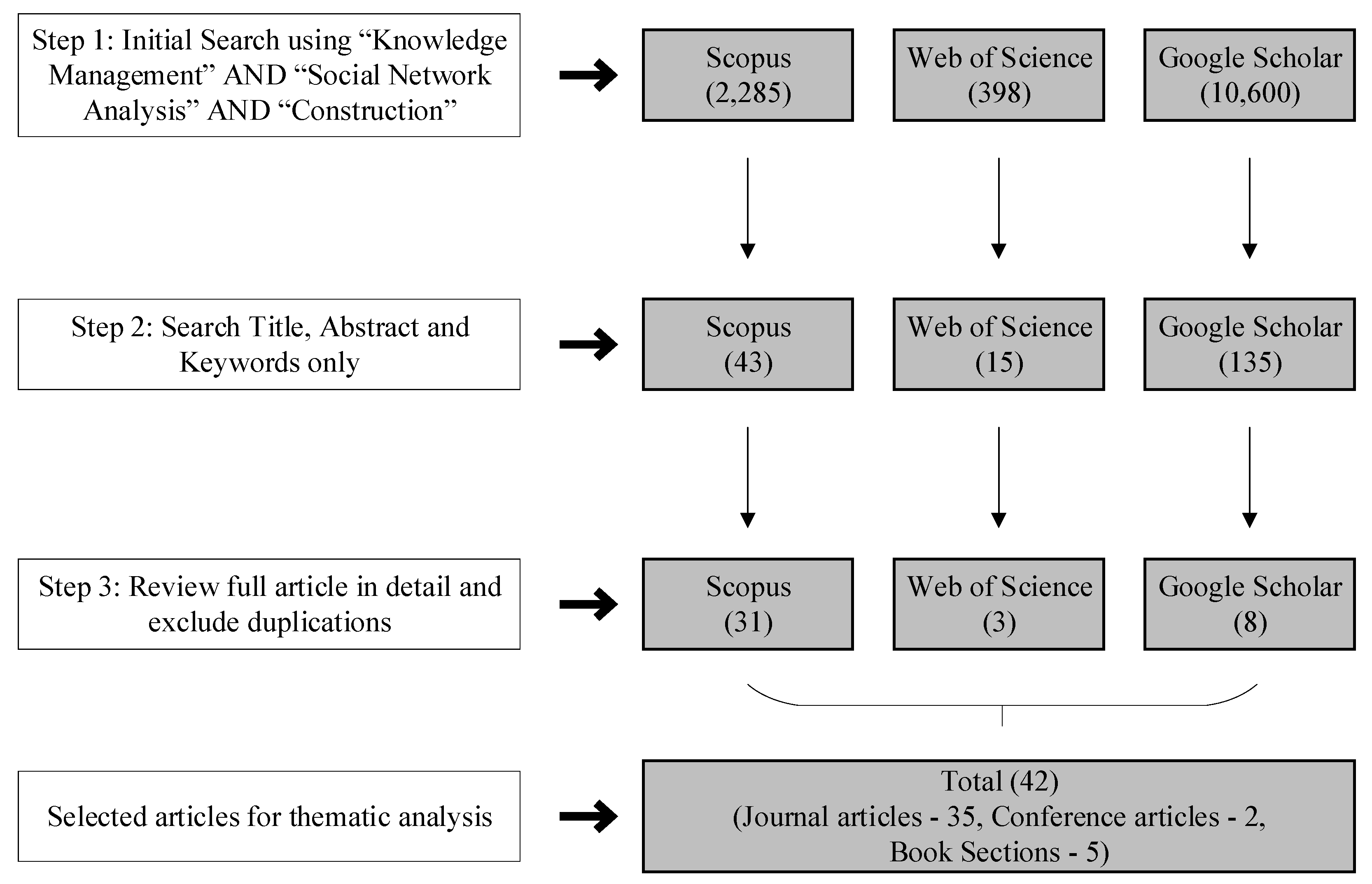
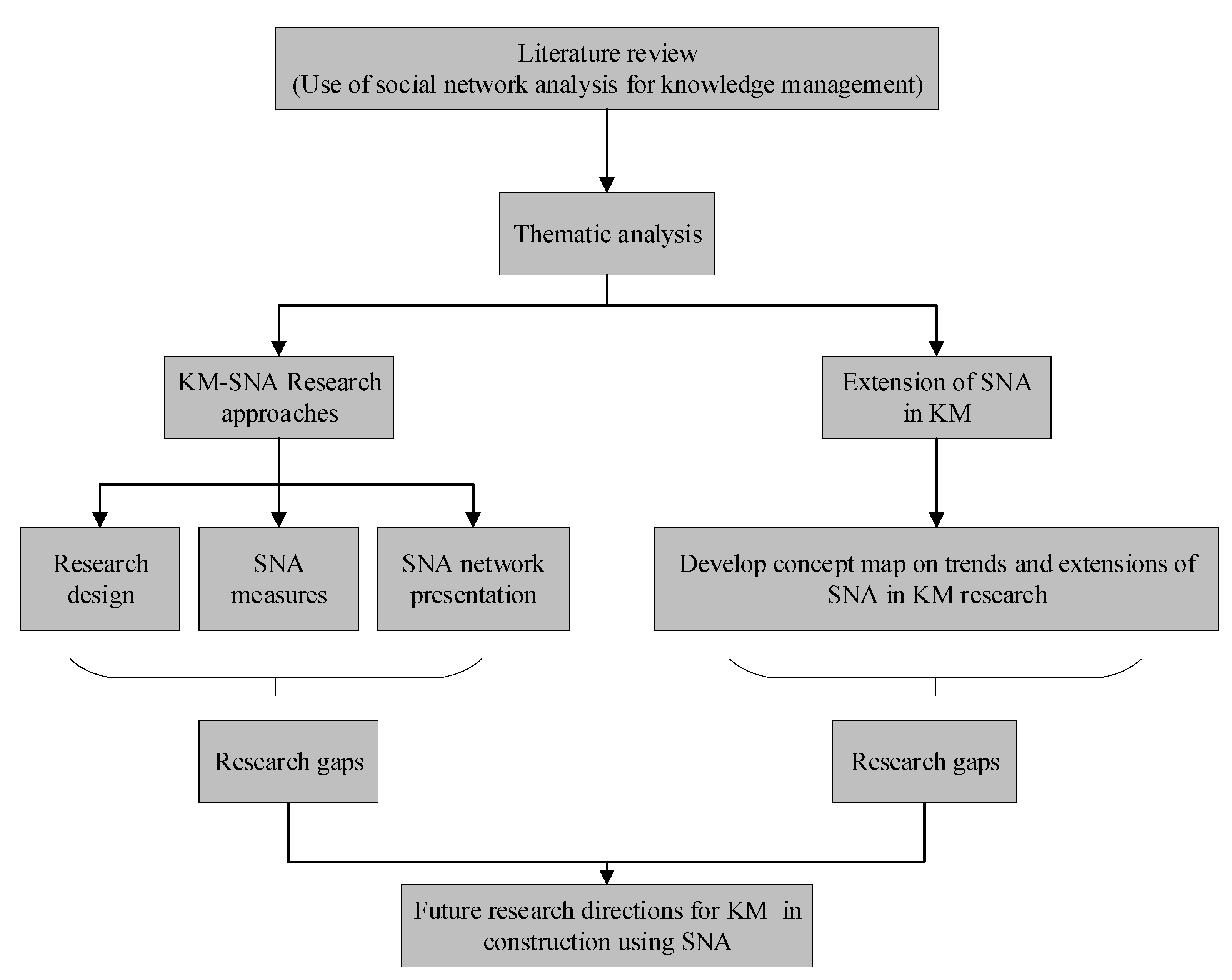
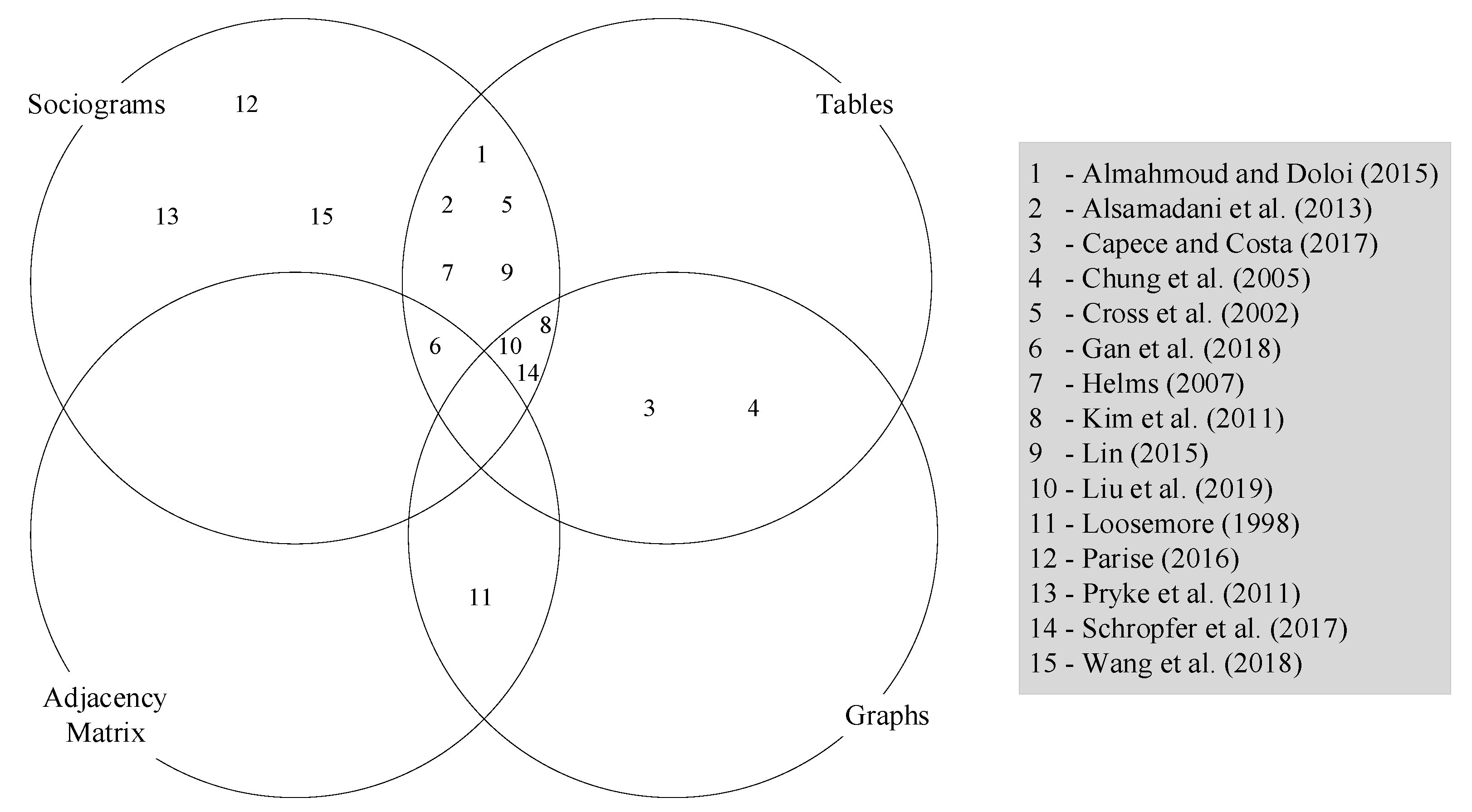
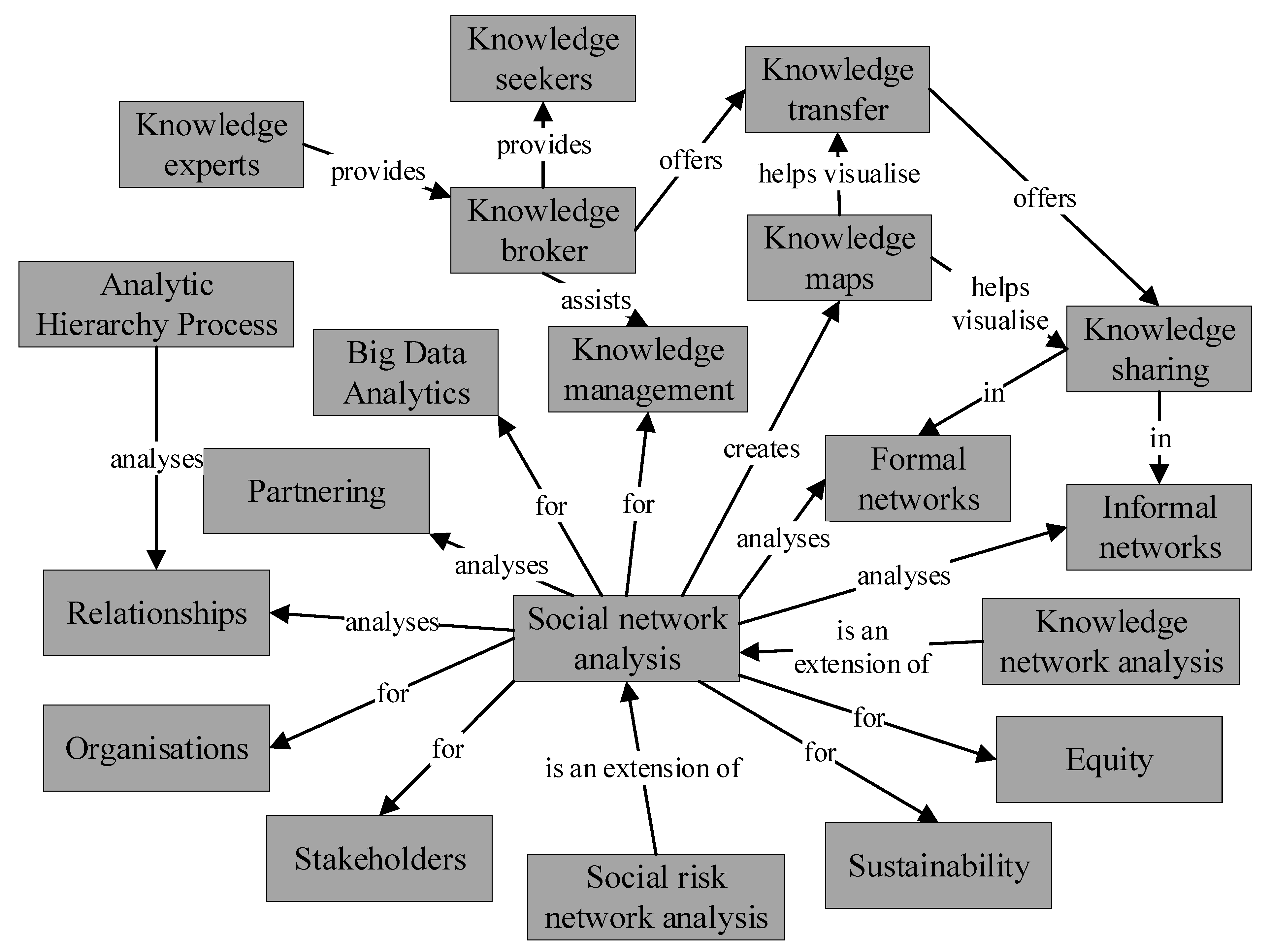
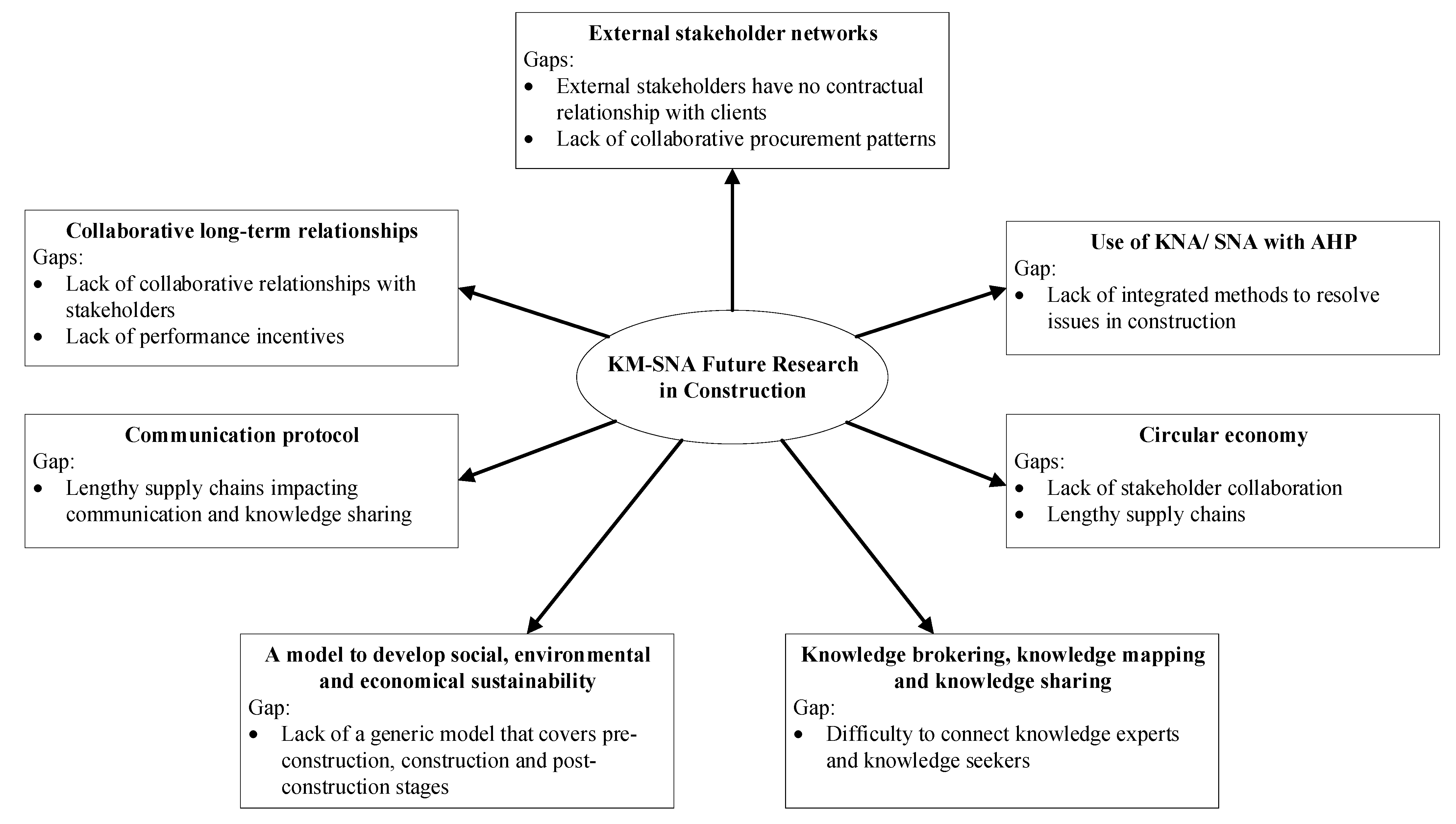
| Studies in Various Industries | ||
|---|---|---|
| Study | Description | Features of Case Study Design |
| Kim et al. [7] | A Knowledge Brokering System (KBS) is introduced to create the link between knowledge seekers and knowledge experts. This system uses several SNA measures to calculate the expertise index, which assists in selecting experts. | A single project team consisting of 10 members in a Korean financial company were considered to collect data and validate the functions of the KBS. |
| Capece and Costa [32] | This study proposes an evaluation method based on SNA and team configuration indexes to measure knowledge creation in virtual teams. 4 virtual teams within a single case study have been used to collect data and evaluate the relationships between the actors using SNA. | 4 independent virtual teams (each comprising of 6 members) in an Italian manufacturing company were considered and data were collected using an autoevaluation questionnaire with closed questions using likert scale or multiple-choice questions. |
| Studies in Construction | ||
| Study | Description | Features of Case Study Design |
| Lin [33] | In this study, job-site social networks including order-management, technical-consultation, and interpersonal-social networks in the Husan dam project in Taiwan are analysed using SNA measures to discover underlying job-site management issues and potential technology interfaces. | 70 participants involved in Husan dam project in Taiwan contributed to the data collection process carried out in the form of a questionnaire. These participants were from 9 organisations, including the owner company, 2 consultancy firms, and 6 subcontractors. |
| Almahmoud and Doloi [34] | The proposed dynamic assessment model, developed using sustainability and equity theories, was evaluated using SNA to map the relationships between stahkeholders. | 20 participants engaged in 14 different roles, such as contractor, supplier, owner and so forth, in a project in Saudi Arabia were analysed using a questionnaire with a 7-point Likert scale. |
| Wang et al. [35] | SNA was used in this study to evaluate the suitability of the proposed multi-layered conceptual framework that incorporated social sustainability and construction. | The network participants in a turnkey building renovation project were analysed using a questionnaire. |
| Loosemore [36] | In this study, crisis management in the UK construction industry is explored especially focusing on interpersonal communication networks under conditions of crisis. SNA is used to analyse the management of construction crises and concluded that both quantitative and qualitative methods are needed to understand complexity of people’s changing social roles, positions and behaviours. | SNA, along with an adjacency matrix, was used in a leisure centre project that involved crisis management to analyse its communication networks between various stakeholders. |
| Liu et al. [37] | An SNA-based method is used to investigate equipment movement between project sites and equipment shops. The study proposed a novel index, direct dispatch index, along with the coefficients of SNA to measure the equipment dispatching performance with the use of equipment logistics data collected from the equipment and project management system of a company in Alberta, Canada. The study revealed that equipment management could be enhanced through improved decision-making. | Equipment movement data was collected from an internal equipment management system of construction contractor in Alberta, Canada, between 2013 and 2016. |
| Studies in Various Industries | ||
|---|---|---|
| Study | Description | Features of Case Study Design |
| Parise [38] | It used three case studies to explore how SNA contributes to knowledge management efforts related to human resources professionals within organisations. | 3 case studies were selected to observe the relationships between actors within the networks in these 3 different organisations. Questionnaires with follow up interviews have been conducted to collect data. |
| Helms [39] | Knowledge Network Analysis is a novel technique which was introduced and explored using case studies to identify the bottlenecks of the technique. | Data were collected from 3 social networks in 3 different offices in the Netherlands using a questionnaire. |
| Cross et al. [40] | Multiple case studies were considered to observe how organisations could support work occurring in informal networks of employees. In this study, the data were collected from 40 informal networks from 23 organisations. It was revealed that informal relationships among employees provide more reflection of the way work happens in an organisation rather than relationships established by the organisational hierarchy. | 40 informal networks from 23 different organisations were considered for data collection, which was conducted in the form of questionnaire and interviews. |
| Studies in Construction | ||
| Study | Description | Features of Case Study Design |
| Pryke et al. [41] | Resource provision ego-networks are investigated structurally in this study using social network analysis. | The ego-centred personal networks of 6 small construction business owners in Greece were interveiwed. |
| Schröpfer et al. [42] | This study examines knowledge transfer practices in sustainable construction projects using SNA. | Questionnaires were distributed among workers in 5 construction projects that delivered sustainable office buildings in Germany and the UK. The network sizes were 125, 39, 38, 50, and 35. |
| Alsamadani et al. [43] | Safety communication between parties in small construction crews was explored using SNA to identify communication patterns in effective and ineffective safety netowrks. | 9 small crews where their network sizes varied between 5 and 12, working in building construction projects in Denver, USA, contributed to the study through questionnaires and follow up interviews. |
| References | SNA Measures | |||||
|---|---|---|---|---|---|---|
| Degree Centrality | Closeness Centrality | Betweenness Centrality | Tie Strength | Density | Other (Eigenvector Centrality, Clusters, Brokerage, Bridges etc.) | |
| Almahmoud and Doloi [34] | ✓ | |||||
| Alsamadani et al. [43] | ✓ | ✓ | ✓ | |||
| Capece and Costa [32] | ✓ | ✓ | ||||
| Chung et al. [46] | ✓ | ✓ | ✓ | |||
| Gan et al. [45] | ✓ | ✓ | ✓ | |||
| Helms [39] | ✓ | ✓ | ||||
| Kim et al. [7] | ✓ | ✓ | ✓ | ✓ | ||
| Lin [33] | ✓ | ✓ | ✓ | |||
| Liu et al. [37] | ✓ | ✓ | ✓ | ✓ | ||
| Loosemore [36] | ✓ | ✓ | ✓ | |||
| Parise [38] | ✓ | ✓ | ✓ | |||
| Pryke et al. [41] | ✓ | ✓ | ||||
| Schröpfer et al. [42] | ✓ | ✓ | ✓ | ✓ | ||
| Wang et al. [35] | ✓ | ✓ | ✓ | ✓ | ||
Publisher’s Note: MDPI stays neutral with regard to jurisdictional claims in published maps and institutional affiliations. |
© 2021 by the authors. Licensee MDPI, Basel, Switzerland. This article is an open access article distributed under the terms and conditions of the Creative Commons Attribution (CC BY) license (https://creativecommons.org/licenses/by/4.0/).
Share and Cite
Senaratne, S.; Rodrigo, M.N.N.; Jin, X.; Perera, S. Current Trends and Future Directions in Knowledge Management in Construction Research Using Social Network Analysis. Buildings 2021, 11, 599. https://doi.org/10.3390/buildings11120599
Senaratne S, Rodrigo MNN, Jin X, Perera S. Current Trends and Future Directions in Knowledge Management in Construction Research Using Social Network Analysis. Buildings. 2021; 11(12):599. https://doi.org/10.3390/buildings11120599
Chicago/Turabian StyleSenaratne, Sepani, Muhandiramge Nimashi Navodana Rodrigo, Xiaohua Jin, and Srinath Perera. 2021. "Current Trends and Future Directions in Knowledge Management in Construction Research Using Social Network Analysis" Buildings 11, no. 12: 599. https://doi.org/10.3390/buildings11120599
APA StyleSenaratne, S., Rodrigo, M. N. N., Jin, X., & Perera, S. (2021). Current Trends and Future Directions in Knowledge Management in Construction Research Using Social Network Analysis. Buildings, 11(12), 599. https://doi.org/10.3390/buildings11120599









